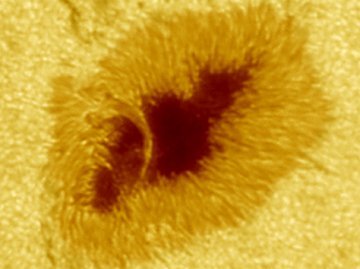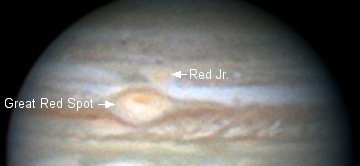 The space shuttle is orbiting Earth. Would you like to see it? Sign up for Spaceweather PHONE.
The space shuttle is orbiting Earth. Would you like to see it? Sign up for Spaceweather PHONE.
STATION SIGHTINGS: If you notice a bright, unwavering light gliding through the evening sky this week, you've probably spotted the International Space Station. Quick--point your telescope. With a little magnification, you can see solar arrays, living quarters, and maybe even the space shuttle Discovery paying a visit. Example: Tom Gwilym of Renton, Washington, took this picture of the ISS using a 12-inch telescope on July 1st.
SOLAR RADIO: Giant sunspot 898 is splitting in two, sending shock waves through the sun's atmosphere and radio bursts toward Earth. Yesterday in New Mexico, radio astronomer Thomas Ashcraft recorded an impressive 18 MHz outburst: listen.

Photo credit: Philippe Vercoutter of Ypres, Belgium.
If you have a solar telescope, keep an eye on this sunspot. It has been active for days and shows no signs of quieting.
more images: from Philippe Vercoutter of Ypres, Belgium; from Pavol Rapavy of Rimavska Sobota, Slovakia; from Peter Paice of Belfast, Northern Ireland; from Gianluca Valentini of Rimini, Italy; from Jan Timmermans of The Netherlands.
RED vs. RED JR: The long-awaited collision between Jupiter's Great Red Spot and Red Jr is underway. So far, both storms are holding their own:

Photo credit: Christopher Go of Cebu City, the Philippines.
Closest approach "should happen late next week," says Philippine astronomer Christopher Go who has been tracking the storms's convergence. Although no one knows what will happen, researchers have offered some possibilities: Storm bands may peel off, forming new turbulent curly-cues. Red Jr might lose its red color, turning white. Or the two storms could pass unscathed and unaltered.
See for yourself: Jupiter is an easy target for backyard telescopes. It appears in the evening sky, popping out of the twilight about halfway up the southern sky: finder chart.

